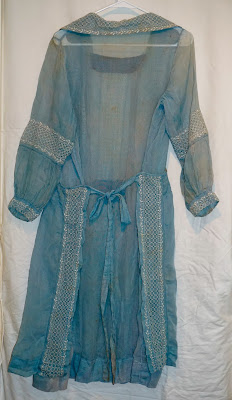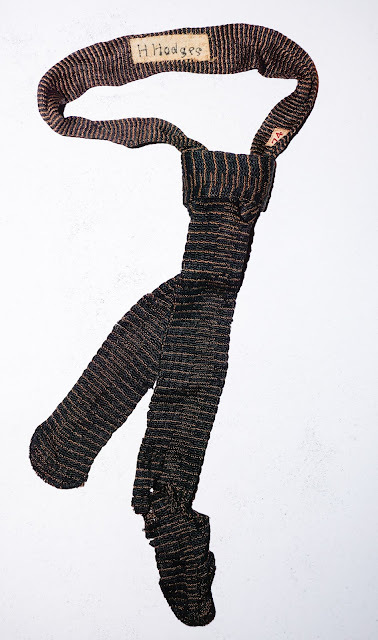Dress Rehearsal
 |
| Mary Elizabeth Hendrick Hodges |
One of the newest items to be rediscovered at the Sutherland Springs Historical Museum is a container of old dresses from the early twentieth century. Beulah Wilson reports that after Jesse Mae and Joe Wesley Tatum purchased
the Tiner-Hendrick house on 20 December 1994, they donated an old trunk full of
women’s clothes to the Sutherland Springs Museum. We discovered the dresses in a plastic container. There is an old trunk among the items at the museum. We do not know if that trunk is from the Tiner-Hendricks house, but we're confident the dresses are from the there.
Jessie Lane Tiner was one of the early settler along the Cibolo Creek. J. B. Polley in an article called "Oldtimers on the Cibolo" says that J. F. Tiner, J. L. Tiner's father, came to the Cibolo in 1851.
Tiner, in his 1886-1889 journal recounts that the first crop his father planted in Texas was in the spring of 1852 on February 15th. He carried on his farming for
30 years and the whole time on the same farm at the old Gonzales Crossing of the Cibolo. It is the crossing of the first trail from Gonzales to San Antonio say 50 years or more ago from the no. of old musket balls we used to pick up around near the crossing when we were little chaps. I think it must of been a general camping place for old Gen'l Sante Anna. (Mexican) before the battle of San Jacinto when Gen'l Sam Houston captured old Sante Anna and gained the Independence of Texas. Since that Battle Texas has been prospering and today bids fair to be the greatest state in the Union in 50 or 100 yrs. more. She is fast settling up with farmers, mostly Germans.
The 1886-1889 diary also records his addition of the "new house" to the "old house." The house is still standing and in desperate need of someone to gently restore it.
In 1900 Tiner sold the house to Gertrude Hendrick and moved to Uvalde, where he eventually ended up keeping bees on the Frio River .
Gertrude and her daughters, Mary Elizabeth, Angela, and Veronica, moved into the Tiner house. John Kane Hendrick had died a few years earlier, 9 November 1883. His story is worth a blog of its own. Look for that in the near future. In 1903 Gertrude's oldest daughter, Mary Elizabeth ("Mae") married Jessie Gordon Hodges, a staunch Baptist educated at Baylor University and an independent geologist, and moved to Waco, Texas. Mae had three children: John Hendrick Hodges (1906), Gertrude Theresa (1908) and Joseph Gordon (1910). Gertrude died at 14 months, purportedly from a rattlesnake bite in her crib. The next year, after the birth of her last child, Mae found it hard to cope and the family moved back to the old homeplace in Sutherland Springs, where her unmarried sisters could help her care for the children.
These dresses could have belonged to Gertrude, May, Angela, or Veronica. Some of the dresses are petite and some are of a larger size. Many of the dresses have dozens of snaps and hooks and eyes for closures. Sometimes it was difficult to determine how to dresses were actually put together. Almost all are handmade.
This dress was likely several shades deeper when it was first made. There is a little gathered area above the left knee. I am not sure what purpose it served. The braiding on the cuffs, collar, and bodice adds an elegant touch. Again the garment is fastened with many snaps and hooks and eyes.
This cotton dress with lace enlays is the only one with buttons as fasteners. There are eighteen tiny buttons down the front of the dress, with two hooks and eyes thrown in for good measure. How long would it have taken to get dressed?
This pretty blue dress with a silk feel has a sewn-in dickie. I wonder if the dickie was for modesty, to keep the dress clean, or just to gussy up the outfit.
This aqua cotton organza dress has a removeable apron. The bodice has hooks and eyes down one side.
This style has lost the waist line, although belt loops along the sides indicate that the dress was once worn with a belt of some kind. Delicate lace decorates the front, pockets, sleeves, and collar.
I suppose this is a dressing gown. It has an oriental feel to it.
This purple organza dress is not in very good condition. The ruffles on the sleeves, hem, and collar, and the construction of the cuffs are eye-catching. Tiny tucks cover the bodice, hem, sleeves, and belt.
This is another loose-fitting dress, with the belt still attached. The buttons are ornamental. The dress fastens along the shoulder.
Here is another linen dress with contrasting cuffs and collar. Buttons ornament the sides of the tucked bodice and waist.
This gold brocade sheath dress is much later, perhaps from the sixties.
This pretty blouse is the only garment with a label. The blouse was made by Patty Woodard California, perhaps in the 50s. At first, I mistook the blouse for a baby dress. It's so delicate.
This dress is in the poorest condition. Perhaps it is silk. It has contrasting cuffs and collar and a contrasting off-center inlaid pleat.
This cotton organza dress was a much darker purple when it was first made. Ruffles, bows, decorative buttons, and a lace-inlaid bodice festoon the dress.






































Comments
Post a Comment